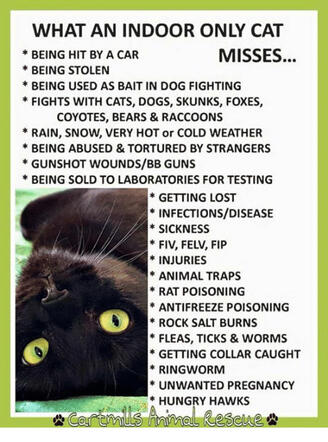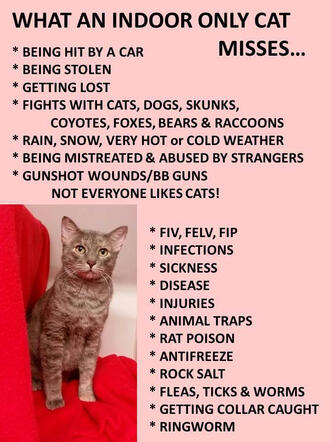Cats and the great outdoors
Outdoor and semi-outdoor cats are not only at an extremely increased risk of early death, heightened chance of being stolen; trapped; injured; contracting & spreading disease and being abused, but also pose a significant risk to wildlife and our ecosystem. It is estimated that Free-ranging domestic cats kill 1.3–4.0 billion birds and 6.3–22.3 billion mammals annually.
Allowing your cat to roam the outdoors without a lead or enclosure has been shown to slice your cats lifespan in half. Outdoor and semi outdoor cats live much shorter lives than indoor cats, outdoor cats tend to live 2-5 years on average while indoor cats live 10-15 years on average.
Sure, outdoor cats might see and discover more things than an indoor cat, but is that really worth cutting his lifespan in half? Is that really worth the harm he causes to wildlife? The harm he causes to neighbors, and even other cats by hogging their resources and fighting with them?
No. If you continue down this page, we'll show you that almost everything an outdoor cat can achieve outdoors, can be achieved indoors without the harm on wildlife and risks to your cat, and that taking away unrestricted access to the outdoors from your cat does not have to mean your cat can never go outside again, or have fun. Keep reading!
Here is a list of pages on the topic of transitioning an outdoor cat to an indoor cat - which can take days to weeks to months, depending on the cat; as all transitions can with cats.
Short overview and tips
Another short but in-depth read on the proccess
7 tips for transitioning
Addressing some arguments
Most often the arguments we hear from people who are pro-outdoor cats tend to center around stimulation - outdoor cats get a ton of stimulation; have a routine day to day, and cannot be expected to just quickly adjust to.. Laying around and eating kibble inside 24/7. First:
Transitioning from outdoors to indoors cannot be expected to go quickly. Transitioning diets, lifestyles, litters, and even routines in cats cannot be expected to go quickly. They are done at the cat's pace. Cat's can take weeks, months, days, or no time at all to transition. All cats are different.
Second, while it is true that former outdoor cats cannot be expected to adjust to that one very specific lifestyle, that lifestyle is not the reality for all indoor cats, does not have to be the reality for your cat, and can be quite easily prevented with bare minimum pet care - like how dogs get to go on walks and play tug of war or play fetch, lest they eat the couch cushions or go bonkers; reaking havoc.
Mental and physical stimulation can be achieved indoors in practical; easy & safe ways. Cats - especially previously outdoor cats - require proper stimulation, routine playtimes, environmental enrichment, a biologically apropriate diet, and can heavily benefit from harness walking, which can offer the same natural stimulation outdoor cats get, especially in conjunction with the previously mentioned stuff.
Simply walking your cat on harness daily on a set routine with proper playtimes; mealtimes, and environmental enrichment can be just as fulfilling for a cat as letting them outdoors is, and as cat guardians, we should all be willing to put in the work to improve your cats quality of life, especially when it comes to such fundamental; basic pet care stuff.
On diet..
Another argument that pops up from the pro-outdoor-cats-camp is on diet - that cats require a fresh naturalistic diet and heavily benefit from a varied diet, and that's correct. However, this can be achieved indoors, so it's not an excuse or a reason to allow your cat outdoors. Raw diets are great, and you can feed your cat a varied diet even containing whole prey indoors just fine. Check the link below for the scoop on that.
All about feline nutrition, raw diets, varied diets, whole prey, everything
Offering natural stimulation!
Cats are obligate carnivores, designed to hunt; catch; kill; eat; groom; sleep; repeat. Day in, day out. This is a cat's natural psychological rhythm, this is true for the species itself, and thus, every cat - even yours.
Routine is incredibly beneficial for cats and routine playtime is essential. Environmental enrichment is incredibly important as well. (catification)
All of these things are integral parts of a felines psychological and biological design, stimulation is incredibly important to a cat's health; mentally and physically, and are key players in ensuring a cat's transition from outdoors to indoors goes smoothly. Below I have listed some wonderful resources by Jackson Galaxy; a cat behaviorist - we are not affiliated nor sponsored by him in any way, his videos are simply the best on the subject. Make sure to watch them all.
As stated in Jackson's video, Indoor Cats Vs Outdoor Cats - catios exist.
Be sure to check out our behavior section for much more on offering stimulation indoors as well!
And as mentioned above...
Harness walking is a fantastic way to offer natural stimulation to your cat in a healthy; safe way!
To learn the ins and outs on harness & leash walking cats, click the link below!
So, in short, there really are no good reasons to allow your cat outdoors unless on a harness. Every positive thing your cat can experience outdoors can achieved safely indoors, paired with harness walking; catios, or a mixture of the two
Please for the wellbeing of your cat and our planet, begin transitioning your cat to being indoor only, and be sure to spread awareness to this issue to your friends who have cats.



